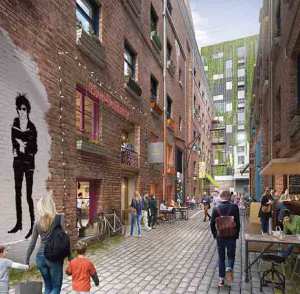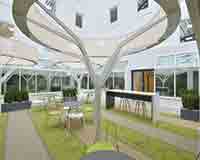
Manchester, the linchpin of the northern powerhouse, is aiming to be at the forefront of the digital workplace revolution.
And its bohemian Northern Quarter, often dubbed the “Shoreditch of the North”, has politicians and developers lining up to associate themselves with its brand.
The Northern Quarter, in the historic centre of the city with its sprawling post-industrial warren, is built around Oldham Street between the city’s two main rail stations, Piccadilly and Victoria. It is home to a thriving startup community, fed by a bustling nightlife and street culture scene.
Brands such as boohoo.com, which designs and produces its fashion from Dale Street, call the area home.
With its listed, quirky buildings and cheap rents, the area is perfect for the young tech firm, and has been positioned as the kind of tech cluster that made Shoreditch such an asset to London in the early noughties.
But the Northern Quarter has grown up in a different world to Shoreditch. Having seen what tech industries can do for a city, big-ticket investors with government and corporate backing are developing schemes offering cheap space for the creative sectors.
The £950m MediaCityUK, Europe’s first dedicated creative and digital business hub, is now home to the BBC, ITV and a myriad of production firms, as well as digital collaboration and startup incubator spaces. The Sharp Project provides host space for digital and communication firms, while the Knowledge Corridor, Manchester Science Park and the £235m Rolls Institute reflect the city’s – and its 100,000 students’ – strengths in the life and materials sciences.
Compare that with Shoreditch, which provided a refuge for cash-strapped startups looking for a chance to secure office space at up to a fifth of the price of the West End.
As Capital & Centric co-founder Adam Higgins says: “It’s a different environment in Manchester. It’s quite small and it’s not as if there are areas that are really cheap compared with the core. There’s no massive disparity in price – the Northern Quarter might be only half the price of Spinningfields.”
That relatively small size, and the pedestrian-friendly nature of the city, also means the Northern Quarter is much more exposed to competition than its southern counterpart, particularly when it comes to inward investment.
Savills associate director Richard Lowe says: “The Northern Quarter has been a bit of a buzzword. [Out-of-town occupiers moving to the city] think it’s the new Shoreditch, then realise what a small city it is. You can walk around, so it’s more about the buildings that are best placed to benefit rather than the locations.”
While Shoreditch can offer room to expand and homes for the big hitters in the tech world, the Northern Quarter cannot offer that kind of modern, scaleable space.
Neil Mort, CBRE head of office agency, says: “As the Manchester market expands I think you’ll find one or two financial tech occupiers moving out to be closer to the financial services firms they cater for.
“As the city grows it’ll be more important to be located on the doorstep of your client. And the Northern Quarter suffers from small buildings with small floorplates. If firms want to grow they have to move out.”
Indeed, Kames Capital’s 80,000 sq ft The Hive on Lever Street is widely recognised as the only grade-A office block in the submarket.
Those startups wishing to expand or to rub shoulders with more seasoned companies are increasingly being tempted elsewhere, as are larger inward investors – as in the case of Trader Media’s 2014 digitally driven relocation from Warrington to Ask Development’s First Street project.
Developers have been quick to capitalise. Henry Boot’s joint venture with Capital & Centric is working up its own challenger, with its nearby Kampus project set to pull plenty of the more trendy occupiers south.
Bruntwood is playing a similar game with its 127 Portland Street to the south-west, offering tech-friendly gimmicks such as “treehouses” in each of its offices.
At the same time, to the west, the behemoth of Spinningfields is reaching out to tech occupiers, with Allied London’s XYZ building – formerly known as the Cotton Building – planning to incorporate a 30,000 sq ft co-working incubator for the fintech and digital arms of their existing occupiers.
Chief executive Michael Ingall says: “We want to create ecosystems where the younger firms can mix with the more developed ones. That has the knock-on effect of attracting the big corporates. It means you can offer a whole culture, more than just a property.”
Having already hit the market with the tech-friendly Hello Work co-working concept, Allied plans to devote the bonded warehouse on its St John’s Quarter site on the former Granada Studios to a media, retail and music tech hub.
It may be that the Northern Quarter will be a victim of the innovation of Manchester’s developers. As Tech City UK’s research has found, Manchester’s property offering is one of the best in the country. And in an expanding city, with ever wider boundaries to its business district, the Northern Quarter, with so many more restrictions than Shoreditch in its infancy, may just start to see its startup dominance ebbing away.











